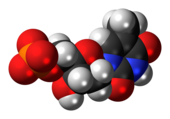Thymidine monophosphate
 From Wikipedia the free encyclopedia
From Wikipedia the free encyclopedia
This article may be too technical for most readers to understand. (April 2022) |
 | |
 | |
| Names | |
|---|---|
| IUPAC name Thymidine monophosphate | |
| Other names 5'-Thymidylic acid | |
| Identifiers | |
3D model (JSmol) | |
| Abbreviations | dTMP |
| 3916216 | |
| ChEBI | |
| ChEMBL | |
| ChemSpider | |
PubChem CID | |
| UNII | |
CompTox Dashboard (EPA) | |
| |
| |
| Properties | |
| C10H15N2O8P | |
| Molar mass | 322.2085 g mol−1 |
Except where otherwise noted, data are given for materials in their standard state (at 25 °C [77 °F], 100 kPa). | |
Thymidine monophosphate (TMP), also known as thymidylic acid (conjugate base thymidylate), deoxythymidine monophosphate (dTMP), or deoxythymidylic acid (conjugate base deoxythymidylate), is a nucleotide that is used as a monomer in DNA. It is an ester of phosphoric acid with the nucleoside thymidine. dTMP consists of a phosphate group, the pentose sugar deoxyribose, and the nucleobase thymine. Unlike the other deoxyribonucleotides, thymidine monophosphate often does not contain the "deoxy" prefix in its name; nevertheless, its symbol often includes a "d" ("dTMP").[1] Dorland’s Illustrated Medical Dictionary[2] provides an explanation of the nomenclature variation at its entry for thymidine.
As a substituent, it is called by the prefix thymidylyl-.
See also
[edit]References
[edit]- ^ Coghill, Anne M.; Garson, Lorrin R., eds. (2006). The ACS style guide: effective communication of scientific information (3rd ed.). Washington, D.C.: American Chemical Society. p. 244. ISBN 978-0-8412-3999-9.
- ^ Elsevier, Dorland's Illustrated Medical Dictionary, Elsevier.